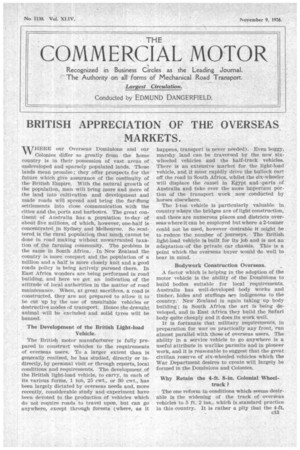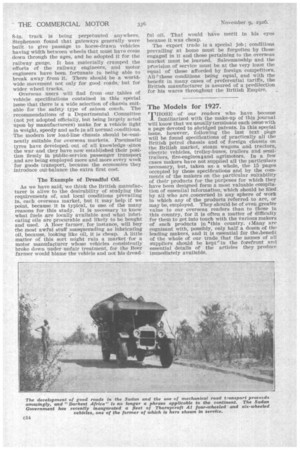MARKETS.
Page 71

Page 72

If you've noticed an error in this article please click here to report it so we can fix it.
WHERE our Overseas Dominions and our Colonies differ so greatly from the home country is in their possession of vast areas of undeveloped and sparsely populated lands. Those lands mean promise ; they offer prospects for the• future which give assurance of the continuity of the British Empire. With the natural growth of the population, man will bring more and more of the land into cultivation and development and made roads will spread and bring the far-flung settlements into close communication with the cities and the ports and harbours. The great continent of Australia has a population to-day of about live millions, of which, however, one-half is concentrated in Sydney and Melbourne. So scattered is the rural populatiort that Much cannot be done in road making without unwarranted taxation of the farming community. The problem is the sanie in South Africa. In New Zealand the country is more -compact and the population of a million and a half is more closely knit and a good roads policy is being actively pursued there. In East Africa wonders are being performed in road building, and here we get an indication of the attitude of local authorities in the matter of road maintenance. When, at great sacrifices, a road is constructed, they are not prepared to allow it to be cut up by the use of unsuitable vehicles or destructive modes of transport. Hence the draught animal will be excluded and solid tyres will be banned.
The Development of the British Light-load Vehicle.
The British motor manufacturer is fully prepared to construct vehicles to the requirements of overseas users. To a larger extent than is generally realized, he has studied, directly or indirectly, by personal visit or through reports, local conditions and requirements. The development of the British light-load vehicle, to carry, in each of its various forms, I ton, 25 cwt., or 30 cwt., has been largely dictated by overseas needs and, more recently, considerable study and experiment have been devoted to the production of vehicles which do not require roads to travel upon, but can go anywhere, except through forests (where, as it happens, transport is never needed). Even boggy, marshy land can be traversed by the new sixwheeled vehiclesand the half-track vehicles. There is an extensive market for the light-load • vehicle, and if must • rapidly drive the bullock cart off the road in South Africa, whilst the six-wheeler will displace the Camel in Egypt and -.parts of • Australia and take over the more important portion of the transport work now conducted by horses elsewhere.
• The 1-ton vehicle is particularly valuable in country where the bridges are of light construction, and there are numerous places and districts overseas where if can be employed but where a 2-fonner could not be used, however desirable it might be to reduce the number of journeys. The British light-load vehicle i4 built for its job and is not an adaptation of the private car chassis. This is a point which the overseas buyer would do well to bear in mind.
Bodywork Construction Overseas.
A factor which is helping in the adoption of the motor vehicle is the ability of the Dominions to build bodies suitable for local requirements. Australia has well-developed body works and timber, hides and stuffings we indigenous to the country. New Zealand is again taking up body building ; in South Africa the art is being developed, and in East Africa they build the Safari body quite cheaply and it does its work well: It is fortunate that military requirements, in preparation for war on practically any front, run almost parallel with those of overseas users. The ability in a service vehicle to go anywhere is a useful attribute in warlike pursuits and in pioneer work, and it is reasonable to suggest that the great civilian reserve of six-wheeled vehicles which the War Department desires to create will largely be formed in the Dominions and Colonies.
Why Retain the 4-ft. 8-in. Colonial Wheel track ?
The one reform in conditions which seems desirable is the widening of the track of overseas vehicle's to 5 ft. 2 ins., which is. standard practice in this country. It is rather a pity that the 4-ft. 8-in. track is being perpetuated anywhere. Stephenson found that gateways generally were built to give passage to horse-drawn vehicles having width between wheels that must have come down through the ages, and he adopted it for the railway gauge. It has materially cramped the efforts of the railway engineers, and motor engineers have been fortunate in being able to break away from it. There should be a worldwide movement not only for good roads, but for wider wheel tracks.
Overseas users will find from our tables of vehicle specifications contained in this special issue that there is a wide selection of chassis suitable for the safety type of saloon coach. The recommendations of a Departmental Committee (not yet adopted officially, but being largely acted upon by manufacturers) make for a vehicle light in weight, speedy and safe in all normal conditions. The modern low load-line chassis should be.etnifiently suitable for overseas markets. Pneumatic tyres have developed, out of all knowledge since the war and they have now established their position firmly in public-service passenger transport and are being employed more and more every week for goods transport, because the economies they Introduce out-balance the extra first cost.
The Example of Dreadful Oil.
As we have said, we think the British manuface turer is alive to the desirability of studying the requirements of, and local conditions prevailing in, each overseas market, but it may help if we point, because it is typical, to one of the many reasons for this study. It is necessary to know what fuels are locally available and what lubricating oils are procurable and likely to be bought and used. A Boer farmer, for instance, will buy the most awful stuff masquerading as lubricating oil, because, looking like oil, it is cheap. A little matter of this sort might ruin a market for a motor manufacturer whose vehicles consistently broke down under unfair treatment, for the Boer farmer would blame the vehicle and not his dread ful oil. That would have merit in his eyes because it was cheap.
The export trade is a special job ; conditions prevailing at home must be forgotten by those engaged in it and those pertaining to the overseas market must be learned. Salesmanship and the provision of service must be at the very least the equal of those afforded by foreign competitors. All 'these conditions being equal, and with the benefit in many cases of preferential tariffs, the British manufacturer is assured of a predilection for his wares throughout the British Empire.
The Models for 1927.
THOSEof our readers who have become 1 familiarized with the make-up of this journal will know that we usually terminate each issue with a page devoted to abridged patents. In this special issue, however, following the last text page will be found specifications of practically all the British petrol chassis and of foreign chassis on the British market, steam wagons and tractors, electric vehicles, trolley-buses, trailers and semitrailers, fire-enginesutand agrimotors. In a few cases makers have not supplied all the particulars necessary, but, taken as a whole, the 15 pages occupied by these specifications and by the comments of the makers on the particular suitability of their products for the purposes for which they have been designed form a most valuable compilation of essential information, which should be filed by all who are concerned in any sphere of work in which any of the products -referred to are, or may be, employed. They should be of even greater value to our overseas readers than to those in this country, for it is often a matter of difficulty for them to get into touch with the various makers of such products in.this country. t Many are cognizant with, possibly, only half a dozen of the leading makers, and it is essential for the pbenefit of the whole of our trade that the names of all suppliers should be kept" 1n the forefront and essential details of the articles they produee immediately available.












































































































































































































